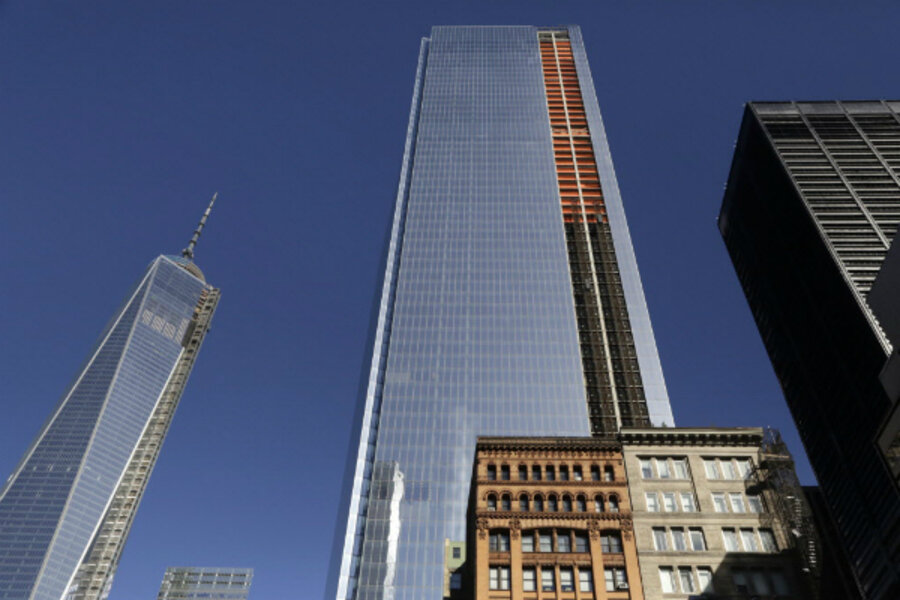4 World Trade Center opens, a shining symbol of a vibrant New York
Loading...
| NEW YORK
Gleaming with "quiet dignity" on a bright November morning, 978-foot-high 4 World Trade Center opened its doors Wednesday, the first skyscraper to open on the original site of the iconic Twin Towers since their destruction 12 years ago. It was a symbolic moment for New York’s “ground zero” after more than a decade of painstaking construction that reshaped Manhattan’s southern tip – and perhaps its psyche, too.
The opening of 4 World Trade – a reflective, glass-encased structure with lines so subtle its 72 stories almost seem to disappear into the sky – comes just a day after its neighbor, 1 World Trade, was declared to be the tallest building in the country. A ruling by the Council on Tall Buildings and Urban Habitat, the independent organization that officially determines the world’s tallest buildings, confirmed on Tuesday the former “freedom” tower’s symbolic height of 1,776 feet.
But Wednesday belonged to the simplicity and elegance of 4 World Trade, whose 2.3 million feet of office space will house the Port Authority and the city’s Human Resources Administration – although 40 percent of the building still needs tenants.
“As we open its doors, the site once again becomes a part of New York’s continued growth, reconnected with the city that surrounds it,” Mayor Michael Bloomberg said at Wednesday morning’s ribbon cutting ceremony. “This is a major turning point for the World Trade Center, and really for our entire city.”
Indeed, for all the symbolism of Wednesday’s opening, New York has changed in unexpected ways since ground zero was a pile of smoldering ruins, devastating the economy downtown. Today, Manhattan’s skyline has been transformed with a number of new gleaming glass skyscrapers, and New York’s economy has rebounded to the point where it is more than ever a city of world trade – as well as one of the safest big cities on the globe.
“Twelve years later, let’s look at it,” says Leslie Himmel, a partner in Himmel + Meringoff Properties and the highest ranking female landlord in the city with over 2 million square feet of office space in Manhattan. “The city has become an international capital in a way it wasn’t before.... I don’t think anybody could have predicted the huge amount of foreign money coming into Manhattan for both offices and residences.”
Even as the global and national economy has remained tepid, New York has seen stability and growth, especially in big project real estate.
“Because of the financial and economic unrest worldwide, New York has become a place for investors to park their money,” says Bruce Bronster, a real estate attorney and partner at Windels Marx, a Manhattan-based law firm. “They believe it’s a safe haven for investment, and they’re investing in real estate – individuals are investing, foreign banks are investing, sovereign funds are investing – there’s lots of money that’s coming here.”
The soaring 4 World Trade hardly evokes the concrete austerity of the former Twin Towers, which had little space for people to sit outside or talk or walk with each other.
And since the new skyscraper stands directly adjacent to the 9/11 memorial, Fumihiko Maki, the award-winning Japanese architect, designed an understated, almost deferential building that is basically what one critic called “a silvery extrusion of a trapezoid atop a parallelogram.” Unlike the gothic severity of the former towers, 4 World Trade's mirrored windows reflect the rest of the city and the expanse of the sky.
“This building can be seen from distances away – it’s a very large building,” said Gary Kamemoto, a director at Maki & Associates, in a video interview with The New York Times. “But at the same time, if that kind of quiet dignity can be seen from afar, that, too, becomes a symbol of the World Trade Center.”
It’s lobby, too, is made of a polished Swedish black granite that faces the memorial – giving those entering the building a reflected view of the memorial park’s trees and the footprint’s reflecting pools. On the other side is a more active transit hall and shopping center.
There’s a sense in which, too, the new skyscraper evokes a tempered vision of the city’s revved-up economic engine. At the center of all the highly charged monuments to capitalism lay what many see as sacred ground.
“Our duty is to create a memorial to those friends, neighbors, and co-workers lost on 9/11,” said Larry Silverstein, the lease holder and developer of the World Trade Center site, which is owned by the Port Authority of New York and New Jersey. “But we’re also charged with creating a vibrant neighborhood, a better version of New York.”
Still, the rebuilt site is already teeming with visitors – shoppers and tourists, as well as an international cast of finance and tech workers that will be arriving soon.
“The new World Trade Center is not just symbolic, it’s going to be the home to hundreds and hundreds of business and retail establishments,” says Mr. Bronster, who currently has clients negotiating to be included in the retail concourse on the site. “The museum will be there, the transportation Oculus, and there’s going to be a retail concourse that is so magnificent that it’s going to be an architectural destination.”







